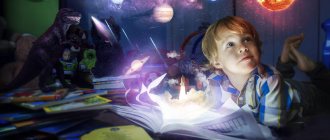Sometimes you can hear about a person: “He is completely devoid of imagination!” Basically they say this about people who don’t know how to fantasize. But is the development of fantasy and imagination really necessary for modern man? Scientists claim that imagination is as important a mental process as thinking, memory, and attention. Without it, there will be no great discoveries and works of genius, inventions necessary for humanity. Life itself will become boring and dull without imagination.
Imagination expands the possibilities of cognition and transformation of the world around us
Difference between imagination and fantasy
Imagination is a type of thinking when we create new ideas and images “in our head” based on the knowledge we have. Moreover, they are formed on the basis of real knowledge, that is, theoretically they can be brought to life. This is how imagination differs from fantasy.
When imagining, adults and especially children also come up with new, but still unrealistic, images and situations. Fantasy allows us to create absolutely any plot, even a fairy tale. To fantasize, you don’t need to take into account any physical laws and have great knowledge.
Let's say we need to solve a problem. Imagination will suggest a non-standard, but real and completely feasible solution, based on our experience and knowledge. But with the help of imagination we can solve it any way we want. There are no restrictions. Therefore, it is best for children to begin developing their thinking with fantasies.
Imagination in adults develops through expanding their horizons, accumulating information, experience and images. It has periods of recession and recovery. The latter are also called inspiration. However, scientists have come to the conclusion that inspiration most often comes to us during the work process, when we have already put in a lot of effort and work.
Drawing
In addition to developing imagination and creativity, drawing helps relieve stress and emotional tension.
You can draw chaotic lines and shapes, or, on the contrary, try to sketch a story and create a comic book. A great idea would be to try to portray any emotions : fear, jealousy, rage, resentment, delight.
In this case, you can use different drawing tools: pencils, paints, crayons. The more color shades are used, the brighter the drawing will be.
A few more ideas: draw music or do this type of creativity with friends . Collective exercises are no worse than individual exercises. Let one person from the company draw a certain figure, and others will try to complement it, and so on until someone decides that the picture has already made sense.
Drawing
What is imagination like?
There are different types of imagination.
- Recreating . It is based on experience. It is also called reproductive (reproducing). Imaginary images are based on existing phenomena and events.
- Creative . New images are created according to one’s own design, with virtually no recourse to experience. It is used practically in areas of human activity (science, art, technology, etc.).
According to the degree of activity, the following types of imagination are distinguished.
- Active . Using it, a person realizes invented images and ideas. It stimulates a person to actively create and therefore requires quite a lot of effort. Especially when newly created images are needed for professional activities (illustrators, writers, fashion designers, etc.).
- Passive . Does not stimulate a person to implement invented ideas. A person is simply satisfied with the result of his imagination. Or these ideas are not yet feasible in principle.
Creative thinking refers to active imagination. After all, the created ideas and images are subsequently implemented. But dreams are passive imagination. They in no way motivate a person to take active action.
A type of reconstructive imagination is spatial. It is used by humans in various fields of activity. Helps create new objects and images through the use of information about objects and space already available in memory.
Watch the course on developing imagination from Wikium.ru right now. And in general, register on the site, try different exercise machines. I recommend this project in almost every article about thinking, memory, communication between people, because it is really very good.
How can we help?
Imagination is undoubtedly the basis for the development of mental abilities. Here the child’s abilities to solve creative problems and intellectual issues are improved. Imagination is one of the sources of thought processes, which must be constantly fed with new knowledge and images. The most effective in this case are books and travel. guide will help you .
Our task with you, dear adults, is to maximally promote the development of children's imaginative abilities. And in children it should be considered as a special form of activity, which will be directed by the preschooler himself to create something new. For example, it could be a drawing, an appliqué, even a fairy tale composed by a child. With the right approach to developing imagination in early preschool age, you will see colossal results in older ones. The little student will easily navigate any plot, offer his own options, and continue composing.
By the way, with regards to teaching activities, it is necessary to note an interesting fact. It lies in the fact that the development of imagination undoubtedly affects the emotional state of the baby. The child receives a charge of positive emotions, and his mood improves. Imagination allows kids to quickly find new ways to solve many problems.
I would like to recommend, dear teachers, good manuals for you “A set of activities for the development of imagination” . You can also take part in interesting webinars, for example this one and this webinar.
I would also like to summarize the above here. Undoubtedly, it is adults who lay down the first mechanisms of imagination. It is precisely in communication with adults that the child assimilates new images developed in society and culture. First it will be actions, then words and speech. We draw conclusions, that is, we communicate with children as often as possible, telling them about the structure of the world around us.
Techniques of creative imagination
Since ancient times, people have used special techniques to create new images. In ancient times, these techniques were used unconsciously. This is how epics, myths, and fairy tales were composed. And nowadays writers, artists and other representatives of creative professions use similar techniques.
- Agglutination . In another way it can be called gluing. A new image or character is created from two or more existing ones. For example, a centaur is half man and half horse. This is an example of simple agglutination. And it is found not only in works of art. Creators of new gadgets also use it, combining the functions of several in one device. For example, a phone with a camera function, etc.
- Hyperbole, litotes . In simple words – exaggeration and understatement. This is one of the simplest techniques for changing real images. With its help, you can transform not only the whole object, but also its individual parts. An example of litotes is Thumbelina.
- Accentuation . This technique is used to especially highlight a certain character trait. For example, in caricatures and cartoons.
- Personification . It consists of giving inanimate objects the characteristics of living beings. Most often found in fairy tales, for example, the talking apple tree and the stove from the fairy tale “Geese and Swans”.
- Typing . According to this principle, an image is created, assembled from typical features characteristic of a certain group of objects. Often used in literature and visual arts. For example, N.V. Gogol used the method to describe the types of landowners in the poem “Dead Souls”.
During the creative process, different techniques complement each other and mix. Thanks to this, it is possible to create unique images and find non-trivial solutions to problems. Both adults and children should master these techniques. And I’ll tell you how to do this further.
Additional Tips
You can develop your fantasy and imagination in any of the presented ways. But with the help of additional tips, you will be able to achieve results faster, and it will be even stronger. Tips include suggestions for lifestyle changes as well as simple workout techniques.
Adviсe:
- Read books every day and fully delve into them;
- Engage in self-development;
- Travel, visit new places at least once a month;
- Look for new inspiration;
- Regularly visit exhibitions, look at art magazines;
- Show curiosity, be interested in the design of technology;
- Expand your interests, try something new;
- Find creative friends, communicate with successful people;
- Dream, imagine a future with unusual events;
- Sometimes use one hand instead of the other;
- Put yourself in the place of book characters, imagine other options for the development of events;
- Voice over characters in movies yourself by turning on the TV without sound;
- Come up with unique fairy tales for your child;
- Invent the fate of people seen on the street, remembering their appearance;
- Visualize real events, imagine what exactly will happen in the future;
- Observe the clouds, try to find famous images among them.
Simple tips like this bring good results. You just need to use them regularly, complementing your basic training.
Giving up bad habits and switching to proper nutrition is of great importance.
Development of imagination in children
In general, approximately the same methods are used to develop imagination in children and adults. However, it is worth taking into account the characteristics of preschool age.
At preschool age, the psyche of children is most sensitive:
- children think primarily in images;
- open to everything new and unusual;
- their images are lively and colorful;
- they are free from stereotypes and thinking patterns that are characteristic of adults.
This refers to the undoubted advantages of the child's psyche. However, there are also negative features that are worth considering.
- Children do not yet have in their memory a large amount of information necessary for the formation of imagination. Therefore, to begin with, it is better to begin to develop imagination and perception. Teach your child to be observant and notice the unusual in simple things.
- Kids get tired quickly and are often distracted. It is difficult for them to engage in mental activity for a long time and concentrate on one thing. Any developmental activities should be enjoyed by the child and carried out with great desire. And the best way to develop imagination is, of course, games and reading books.
We, adults, with our example and enthusiasm can captivate a child - to play together, do exercises, fantasize and thus develop. Joint exercises during walks or long trips are especially effective.
Methods
The best way to develop a child’s imagination is to infect him with your own example. It should be interesting for a child to fantasize. Show him how great it is to come up with something new and unusual. The baby always strives to be like his parents and therefore imitates them in everything.
- Read books written in the fantasy genre together. It is necessary not only to read the work to the child, but also to discuss it and analyze it. For children under 7 years of age, it is best to read fairy tales and short fantasy stories. With a teenager you can already read more serious science fiction novels, for example, novels by Jules Verne, the Strugatsky brothers, etc.
- Ask your child unusual questions. For example, ask him what superpower he would like to have and why.
- Offer your child challenging tasks. For example, a child finds himself on a desert island. What does he have to do to survive?
Exercises
It is best to develop imagination by combining the methods proposed above and various exercises designed to hone creative thinking techniques.
- An animated drawing . Imagine that you have a special gift. Everything you draw will immediately come to life. Imagine with your child what you would like to breathe life into.
- Transformation . A person turns into a bird, an animal, an insect, a plant, into an inanimate natural object, into another person. What will he feel and do? This exercise develops empathy well - the ability to look at the world through the eyes of another object.
- Anthropomorphism . This method involves endowing animate and inanimate objects with human properties. For example, talking animals. Together with your child, come up with 10 similar examples. Together you can compose a fairy tale with invented images.
- A resident from another planet . Invite your child to draw an inhabitant of a distant planet, where living conditions are completely different from those on Earth. For example, the planet is completely covered in ice or the atmosphere consists of burning gases.
- New things . Invite your child to improve ordinary things by giving them new qualities or connecting them with each other. It can be anything: a comb, a toothbrush, a saucepan, a lamp, a pillow, etc.
- The giant and the short one . Imagine with your child that you have become the size of a 5-story building. What disadvantages and advantages will you have? What will you do? It is best to write a story based on this plot. And then imagine the opposite situation - you and your child are reduced to the size of a mouse. What will happen?
Examples of games for preschool children
- Game "Delicious watermelon"
Children often like to bring and show various objects to adults. In this case, you can take advantage of the situation and try to play out the game scene. Let's say a child brought a ball. And the adult comments: “Your ball is very beautiful. Let `s play. It's like a sweet watermelon. Let's cut it. An adult imitates cutting a watermelon with his palm. Then he holds out his empty palm to the baby and says: “Eat a piece of watermelon. It's delicious and sweet. And please cut me a piece.” And then, in another game, the ball can become a bear cub that needs to be put to sleep.
- Game "Look out the window"
For example, a child is interested in a ring and, taking it, walks around the room. You can go up to him and ask: “What is this with you? Probably a window? Let's look out your window together?" Then take turns with your baby and look around the room through the ring. You can name what is visible through it. And so on in the game, the ring can turn into a spyglass or a car steering wheel.
- Game "Colorful Napkins"
For example, an adult offers the child to look at a napkin with flowers. You can suggest to the child: “Look, this is a small clearing, and there are different flowers on it. This is a yellow flower, and this is a red one. Show me where there are still flowers? Let's smell them together?" Next, the adult and the baby begin to smell the flowers, imagining what they smell like. Another time, depending on the color of the napkin, it can turn into a cloud, a dandelion, some water, a leaf from a tree, etc.
- Game "Beautiful Butterflies"
Here you need to prepare a sheet of colored cardboard and a number of pieces of colored tissue paper. Place small pieces of paper on a piece of cardboard and show it to the baby, saying: “Look, this is a clearing. And beautiful butterflies sit on it. We sat and sat, and suddenly we flew and flew.” You need to blow on the leaves, which fly in different directions. And then an adult can invite the child to catch the butterflies and plant them again in the clearing.
Let's play with the plot
- Game "Look for the Bunny"
Offer your child something to do. Take a clean handkerchief or piece of cloth. Hold it by two adjacent corners. Look behind the handkerchief, first on one side, then on the other, and say: “Where is the bunny? Where did you hide? Where are you, bunny? And we will find you now." Then try to quickly tie two corners of the scarf. And make them look like long hare ears. “Where is the tail?” say and tie the other end of the scarf into a small ponytail. Invite your child, “Let’s pet the bunny?” When he is stroking the bunny, you can quietly toss the bunny a little, saying: “Oh, our bunny has gotten naughty. Jumped out. You need to hold him tighter."
- Game "Wolf and Little Goats"
You can use a small box and a few small cubes. Place it all on the table in front of your baby. Say at the same time: “These are little goats. And this is their house. The kids' mother went to the store. And the little goats are nibbling the grass. Suddenly a wolf crept up to the kids.” You can depict a wolf using a large cube or hand, squeezing it. Continue further: “The wolf wanted to eat the kids. But the kids turned out to be very smart and hid from the wolf in their house. Little goats are faster. We will help you hide from the evil wolf." Together with the baby we hide the cubes in the box, and the wolf runs away.
- Game “What are clouds like?”
It is very useful for developing imagination to play games in which a child, together with an adult, can come up with formless objects or objects what it might look like. While walking, invite your child to sit on a bench and look at the sky together. If there are clouds in the sky, you can look at them together and imagine what or who they might look like. Children usually have a very diverse imagination in such a game.
Development of imagination in adults
The imagination works most actively in adults, whose consciousness contains a large number of images. New images and ideas are born on the basis of existing information. And to accumulate rich experience you need:
- read books of different genres (fiction will be especially useful);
- visit exhibitions, museums;
- go to theater performances, movies;
- travel;
- communicate with different people;
- learn new skills.
Methods
To make your imagination work even more actively, use the following methods.
- Develop your powers of observation . Pay attention to everything around you: store signs, flower beds, building facades, and especially people. Take a closer look at passers-by or fellow travelers on public transport. What fate could they have? Make up a story or story about them.
- Get creative . You don't have to have talent to start creating. Drawing, writing poetry or prose, modeling - and this is not all that helps improve imagination. Throw templates and stereotypes out of your head! Invent and create your own unusual creations.
- Use your free time to daydream . When you are alone with yourself, start fantasizing. Imagination will quickly relieve boredom. Mentally picture your dreams. It's better than watching TV or scrolling through social networks. After all, you will be a creator, not a consumer.
- Look for new experiences . You can get them by learning a new activity, visiting places you have never been to before. You don't have to travel far to learn drawing, sewing, baking and other skills. All this is available in any city.
The more you use your imagination, the more solutions you will come up with for any problem. The thinking of a person without imagination is limited to narrow boundaries. It is difficult for him to come up with a non-standard solution to a problem, because he is used to thinking in stereotypes.
Exercises
I want to offer you some simple exercises to develop your imagination.
- Game "Crocodile" . I think you are familiar with this game. She is very funny and good for large groups. It also greatly develops creative imagination. Let me remind you of the rules. One participant whispers a word to the second participant. The second player’s task is to explain this word using gestures to the other players.
- Solving Doodles . Doodles are visual riddles that do not have a clear meaning or correct answer in terms of content. All the images that are born in your head will be true. And the more there are, the better.
- Burime . Another collective and fun game. The first player writes several rhyming lines on a piece of paper. Then he wraps the sheet so that only the last line is visible, and passes the sheet to the next participant. The participant must continue the poem in the same way. At the end of the game, the sheet is unfolded and the resulting “poem” is read aloud.
I also recommend watching a short but very informative video on the topic of the article.
Examples of games for older preschool children
- Game "Magic Figures".
Prepare materials for drawing: pencils, felt-tip pens, paints, wax crayons. First, you can draw six circles on a piece of paper. And then invite the child to complete each of the circles in such a way that you can get different drawings. You can also suggest drawing six squares, triangles or other shapes. By the way, a good guide is “Geometric Puzzles” .
- Game "Funny Triangles"
As a continuation of the previous game, you can offer your child the following option. First cut out many multi-colored triangles from colored cardboard. Invite the preschooler to come up with who or what they can turn into. You can also continue with other geometric shapes.
- Game "Who is Fox"
The task for children will be quite interesting and creative. Place a sheet of paper and colored pencils and markers in front of the child. Just ask them the question: “Who is Fox?” Children need to draw it. Think of someone who might have such a name and offer to come up with a story about him.
- Game "Fairy Blots"
You will need a landscape sheet of paper and paint. One part of the sheet can be thickly painted with paint. After this, the sheet must be folded in half and pressed against the table so that the print comes out. Invite your child to look carefully at this double image and think about what it might look like. You can also offer to complete the details and come up with a story about what happened in the drawing.
- Game "Miracle - Drop"
First prepare a cut out small picture, shaped like a droplet or a pea. The child needs to stick it on a piece of paper anywhere. And then complete the plot in which this figure will participate and come up with a story with it.
The best thing that develops imagination is creativity.
Creativity develops imagination better than games and exercises. Look at famous writers, actors, musicians and singers - they are all people with gigantic imagination and amazing imagination. There are hundreds of creative activities at home that can not only develop your imagination, but also brighten up your time and even gain a profession. Let’s list the main activities:
- drawing;
- modeling;
- embroidery;
- beading;
- singing;
Video on how to develop imagination through drawing.











